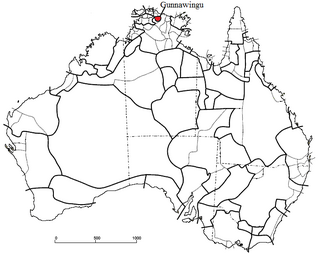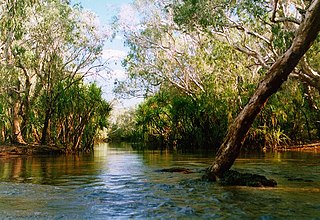This page is based on this
Wikipedia article Text is available under the
CC BY-SA 4.0 license; additional terms may apply.
Images, videos and audio are available under their respective licenses.

The Yolngu or Yolŋu are an aggregation of indigenous Australian people inhabiting north-eastern Arnhem Land in the Northern Territory of Australia. Yolngu means "person" in the Yolŋu languages. The terms Murngin and Wulamba were formerly used by some anthropologists for the Yolngu.
All Yolngu clans are affiliated with either the Dhuwa (Dua) or the Yirritja moiety.
William Lloyd Warner was a pioneering anthropologist noted for applying the techniques of his discipline to contemporary American culture.
Aboriginal Australian kinship are the systems of law governing social interaction, particularly marriage, in traditional Australian Aboriginal cultures. It is an integral part of the culture of every Aboriginal group across Australia.
The Burarra, also referred to as the Gidjingali, are an indigenous Australian people in and around Maningrida in the Northern Territory. Opinions have differed as to whether the two names represent different tribal realities, with the Gidjingali treated as the same as, or as a subgroup of the Barara, or as an independent tribal grouping. For the purposes of this encyclopedia, the two are registered differently, though the ethnographic materials on both may overlap with the other.

The Gunwinggu people are a tribe of Australian Aboriginal people, forming part of the Bininj Gun-Wok peoples, who live to the east of Darwin, Northern Territory.
The Gunavidji, also written Kunibidji or referred to as the Ndjébbana, are an indigenous Australian people of Arnhem Land in the Northern Territory.
The Nguburinji, also written Ngoborindi, were an Indigenous Australian people who traditionally lived in northwest Queensland south of the Ganggalida, north of the Injilarija, west of the Mingin and east of the Waanyi.
The Nunggubuyu are an indigenous Australian people of eastern Arnhem Land in the Northern Territory.
The Djinang are an indigenous Australian people of the Northern Territory.
The Djinba are an indigenous Australian Yolngu people of the Northern Territory.
The Yan-nhaŋu, also known as the Nango, are an indigenous Australian people of the Northern Territory. They have strong sociocultural connections with their neighbours, the Burarra, on the Australian mainland.
The Dangu are an indigenous Australian people of Arnhem Land, in the Northern Territory. They are, according to Norman Tindale, to be carefully distinguished from the Djaŋu.
The Dhuwal are an indigenous Australian people of Arnhem Land in the Northern Territory
The Dhuwala are an indigenous Australian people of eastern Arnhem Land in the Northern Territory.
The Unjadi (Unyadi) were an indigenous Australian people of the Cape York Peninsula of northern Queensland.
The Dalabon or Dangbon are an indigenous Australian people of the Northern Territory.
The Daii or Dhay'yi are an indigenous Australian people of the Northern Territory.
The Gambalang were an indigenous Australian people of the Northern Territory.
The Gungorogone are an indigenous Australian people of the Northern Territory.
The Marra are an indigenous Australian people of the Northern Territory.





